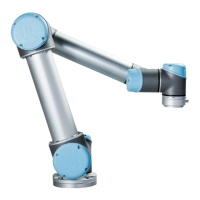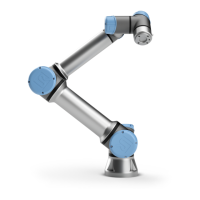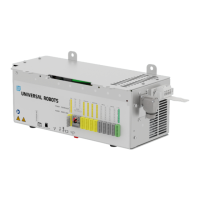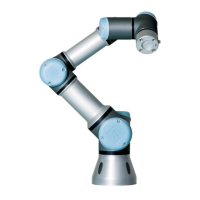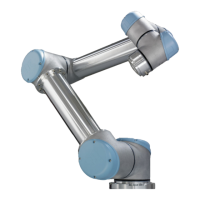11.2 Getting Started
11.2.4 Quick Start
To quickly start up the robot after it has been installed, perform the following steps:
1. Press the emergency stop button on the front side of the teach pendant.
2. Press the power button on the teach pendant.
3. Wait a minute while the system is starting up, displaying text on the touch screen.
4. When the system is ready, a popup will be shown on the touch screen, stating that the
robot needs to be initialized.
5. Touch the button on the popup dialog. You will be taken to the initialization screen.
6. Wait for the Confirmation of applied Safety Configuration dialog and press
the Confirm Safety Configuration button. This applies an initial set of safety pa-
rameters that need to be adjusted based on a risk assessment.
7. Unlock the emergency stop button. The robot state changes from Emergency Stopped
to Power off.
8. Step outside the reach (workspace) of the robot.
9. Touch the On button on the touch screen. Wait a few seconds until robot state changes to
Idle.
10. Verify that the payload mass and selected mounting are correct. You will be notified if the
mounting detected based on sensor data does not match the selected mounting.
11. Touch the Start button on the touch screen. The robot now makes a sound and moves a
little while releasing the brakes.
12. Touch the OK button, bringing you to the Welcome screen.
11.2.5 The First Program
A program is a list of commands telling the robot what to do. PolyScope allows people with
only little programming experience to program the robot. For most tasks, programming is done
entirely using the touch panel without typing in any cryptic commands.
Tool motion is the part of a robot program that teaches the Robot Arm how to move. In
PolyScope, tool motions are set using a series of waypoints. The combined waypoints form
a path that the Robot Arm follows. A waypoint is set by using the Move Tab, manually moving
(teaching) the robot to a certain position, or it can be calculated by software. Use the Move tab
(see 13.1) to move the Robot Arm to a desired position, or teach the position by pulling the
Robot Arm into place while holding the Freedrive button behind the Teach Pendant.
Besides moving through waypoints, the program can send I/O signals to other machines at
certain points in the robot’s path, and perform commands like if. . . then and loop, based on
variables and I/O signals.
The following is a simple program that allows a Robot arm that has been started up, to move
between two waypoints.
1. Touch the Program Robot button and select Empty Program.
2. Touch the Next button (bottom right) so that the <empty> line is selected in the tree struc-
ture on the left side of the screen.
Version 3.11
Copyright © 2009–2019 by Universal Robots A/S. All rights reserved.
II-25 e-Series
